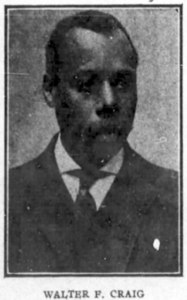
Walter Craig
*Walter Craig was born on this date in 1854. He was a Black violin soloist and orchestra director.
Walter F. Craig was born to Charles A. and Sarah E. Craig in Princeton, New Jersey. He moved to New York City in 1861, where he went to Colored School No. 7 under principal Charlotte Smith, who was succeeded upon her death in 1863 by Sarah J. Smith Tompkins Garnet; by the time Craig graduated in 1869, the school's name had been changed to Colored School No. 4.
He began to study violin in 1868 and held his first concert at Cooper Union in 1870. His musical training was under Hermon Troste, Edward Mollenhauer, and Carl Christian Muller. His musical began with "Craig's Orchestra" in 1872. His orchestra toured, and he became internationally famous as a violin soloist. As a musician, he became associated with several prominent vocalists, including women: Madame Selika, Nelly Brown Mitchell, Adelaide G. Smith, Flora Batson, Emma Azalia Hackley, and Sissieretta Jones and men: L. L. Brown, William I. Powell, Thomas Chestnut, and Harry Burleigh.
His compositions were also well-known. He became the Mendelssohn School of Music concertmaster and was the first Black conductor to join the Musical Mutual Protective Union of New York City. Craig's orchestra was over half white until about 1911, and the union did not support Craig as much as he supported it and white musicians because Craig was Black. By 1887, his orchestra included 75 musicians. In 1893, he was a member of the Antonín Dvořák National Conservatory of Music of America.
Craig gave annual musical concerts. His first yearly Christmas reception occurred in 1880 and continued into the early 1900s. Similarly, in 1880, he presented his first Annual May Festival, which continued into the 1900s. Possibly the most well-renowned annual concert was his pre-Lenten reception, which took place at Palm Garden in New York and continued into the 1910s. Craig's work frequently interpreted classical composers with "exceptional feeling and fidelity" and was crucial in shaping the musical tastes of African Americans in New York City. His abilities stretched beyond classical composition, and his orchestra was in great demand for dance programs.
On December 14, 1898, Craig married Britannia T. Davis, an elocutionist who had a daughter from her previous marriage, Elsie Davis; the couple had a second daughter, Ruth Craig. His wife died at their Brooklyn home on May 16, 1919. The following year, he married the recently widowed former singer Minerva "Minnie" Skanks Conick, whose late husband, Edward Gearing Conick, had been the recording secretary of The Frogs (club).
Later in his life, Craig worked as a violin teacher and became well known for introducing African American musicians to the stage. For example, in January 1915, he featured Roland Hayes in Hayes' premier New York shows. Walter Craig died on January 25, 1933, at Kings County Hospital in Brooklyn.
To Become a musician or Singer
To Become a Conductor or Composer